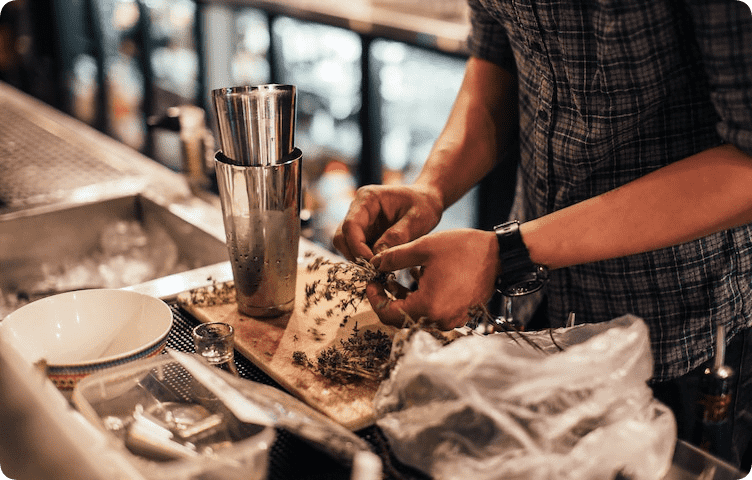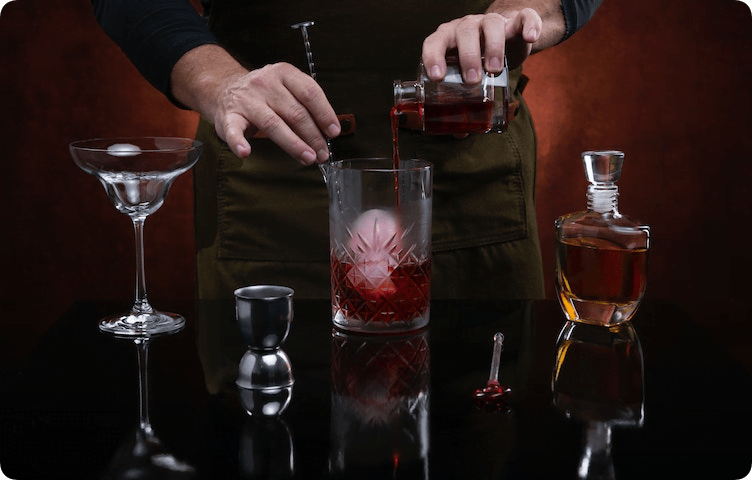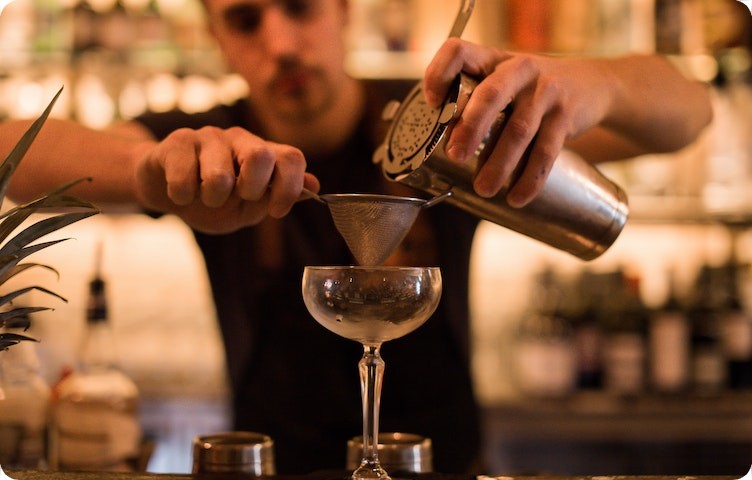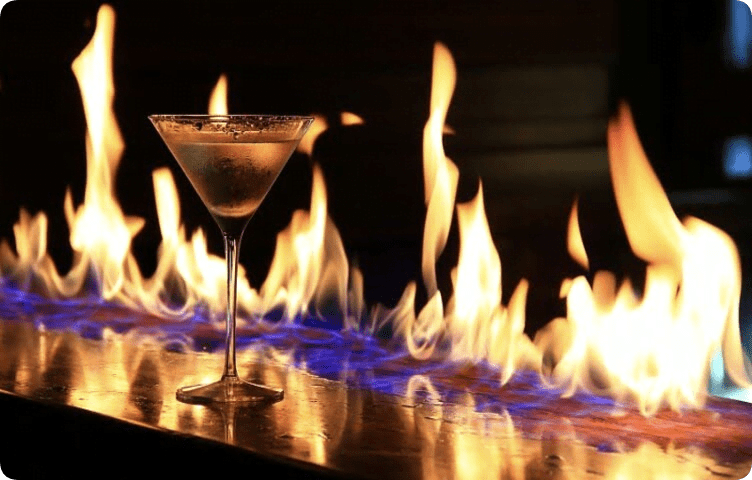Making cocktails is a kind of magical ritual that attracts attention. Just imagine how, in the dexterous and skillful hands of a charming bartender, shakers , glasses , colorful drinks flash and amazing cocktails are created.
There are many nuances and subtleties in the preparation of mixed drinks, and the more the bartender masters them, the more amazing and varied the bar’s cocktail menu.
Depending on the ingredients, the desired structure of the drink and the main idea/author's thought, there are four main ways to prepare cocktails and several auxiliary ones. The main ones include: Shake, Build, Blend, Stir.
Shake

Literally translated as “to shake, shake.” Fitness trainers all over the world shout “shake your body” to their students, but in a bar you can only find a shaker in the hands of a maestro.
The shake method is intended for mixing and cooling difficult-to-mix components (with a thick, enveloping structure: liqueurs, syrups , thick tinctures and milky media).
To prepare cocktails using this method, you need special equipment - a shaker . The main function of the shaker is to obtain a uniform texture of the drink and at the same time cool it. The shaker comes in three main modifications (both in functionality and design): American Boston shaker , European Cobbler shaker and aesthetic French shaker . They are slightly different in details, but the essence is the same for all - the presence of a metal part for rapid cooling, a built-in or additional sieve (strainer) for separating the cocktail from the ice, and the presence of free space inside the shaker to allow the liquid to move when whipping. Depending on the style of use of the shaker, the shake can be:
Long shake is a process of long beating in a shaker, used for textures that are difficult to mix;
Hard shake - a hard, rough, intense shake is necessary to obtain a stable foam. There are components of natural and synthetic origin with excellent foaming properties, such as pineapple juice, egg white or bubble drops. To ensure that the foam has a good texture and remains stable on the cocktail, vigorous movements with the shaker are necessary.
Dry shake – shaking ingredients in a shaker without ice. A dry shake is necessary in cases where an airy structure of the drink is needed. Usually, after shaking a cocktail without ice, the shaker is opened, ice is added and the drink is cooled to the desired texture.
The shaker is also used in such auxiliary and very popular techniques in recent years as rolling and frowling:
- Throwing is one of the ancient techniques for making cocktails, which gained new popularity 5-7 years ago. The idea is to pour the cocktail from one container (part of the shaker) to another (with ice) and the process is repeated several times. The visually impressive technique of pouring with a long stream, on outstretched arms, allows you to well aerate the cocktail, that is, fill its molecules with oxygen and perfectly reveal the flavor profile of the drink.
- Rolling - pouring from one part of the shaker to another. In rolling, the pouring stream is minimal and it is often used without ice. Very suitable for warm cocktails.
Stir

“Shaken, not stirred” and the bewitching look of James Bond won the hearts of millions of women around the world. What lies behind this mysterious “Stir”?
The “wash” method is designed to mix and cool easily mixed components. That is, those drinks whose density does not vary much can be mixed using this method. The stir is prepared in a mixing glass. Ice is poured into it, then all the components of the cocktail are mixed well using a bar spoon , and then poured into a glass through a strainer .
Stir is an elegant method with subtle elements. It is quite simple in theory, but often cocktails prepared by this method require a certain concentration and filigree precision in dosages, such as dashes and drops.
Build
The process of “building” the drink is carried out immediately in the glass. Build is a method in which a cocktail is prepared and served to the guest in the same container. Usually a build is not preparedcomplex cocktails consisting of two or three components, such as Cuba Libre, Screwdriver or Gin and Tonic. But there are also legendary self-sufficient cocktails that give preference to the build - these are Old Fashioned, Mimosa or Rossini. Speaking of sparkling! Often in the build method you can find carbonated drinks (both alcoholic and non-alcoholic), the explanation for this is quite simple - in order to maintain carbonation you need to disturb the bubbles as little as possible, this is possible in the build.
Blend
All cocktails that are prepared in a blender can be safely attributed to the Blend method. This method allows you to use a huge number of ingredients - fresh fruits and vegetables, frozen and fresh berries, ice cream, yoghurts, broths and much more.
When working with a blender, you should remember that you should not place carbonated drinks and citrus fruits in the flask. Carbonated drinks will immediately lose their carbonation and their intended purpose, but from citrus fruits the bartender usually needs juice and there is no point in turning the pulp and white veins of citrus fruits in a blender.
You also need to be more careful when working with ice; if there is a lot of it in the blender, the cocktail will have a thick structure and belong to the Frozen category.
Fine/Double Strain technique (fine strain or double strain)

It involves the use of two devices at once: a strainer and a bar sieve. Many cocktails contain rather small ingredients: rosemary, cumin, fragments of fruits or berries; also, when intensively whipped, ice breaks into small particles and then one strainer is not enough, so a sieve is also connected. Fine Strain is an additional method to Shake or Stir, allowing you to carefully filter the cocktail.
Muddling technique
Another technique that cannot exist separately. Muddle is used in Shake, Steer or Build. Mulder is a small mortar that allows you to crush natural ingredients (fruits, berries, herbs, vegetables). Therefore, the recipe may say “Muddling & Build,” which means that the components must first be crushed, then stirred directly into the glass and given to the guest.
Flaming technique

The "flaming" technique refers to the show presentation. Of course, it does not affect the taste characteristics or nuances of texture, but it undoubtedly affects the effectiveness of the presentation. When a B-52 is set on fire on the bar counter or an experienced bartender prepares a Blu Blazer, the entire bar will be drawn only to this fiery show. Of course, you should remember about safety precautions in a bar and be as confident as possible in your actions, because this is a very dangerous technique from a fire safety point of view, and therefore is prohibited in many establishments.
There are quite a few ways to prepare cocktails, and with each year of work, the bartender discovers more and more nuances in each technique. In any case, always remember about who you are preparing drinks for, about our dear guests, about their preferences and desires.
















































/https%3A%2F%2Fcomplexbar.com%2Fimages%2Fblog%2F243%2Fprigotovlenie-kokteiley.jpg)
/https%3A%2F%2Fcomplexbar.com%2Fimages%2Fblog%2F246%2Funiforma-barmena.jpg)
/https%3A%2F%2Fcomplexbar.com%2Fimages%2Fblog%2F246%2Fkak-nanyat-barmena.jpg)
/https%3A%2F%2Fcomplexbar.com%2Fimages%2Fblog%2F246%2FMadler.jpg)
/https%3A%2F%2Fcomplexbar.com%2Fimages%2Fblog%2F246%2F2024-04-09_17.22.54.jpg)
/https%3A%2F%2Fcomplexbar.com%2Fimages%2Fblog%2F246%2F2024-04-09_17.22.47.jpg)
/https%3A%2F%2Fcomplexbar.com%2Fimages%2Fblog%2F246%2FCODE_anons_foamydrops_752%D1%85480_eng.jpg)
/https%3A%2F%2Fcomplexbar.com%2Fimages%2Fblog%2F246%2FAlina_752%D1%85480_eng.jpg)
/https%3A%2F%2Fcomplexbar.com%2Fimages%2Fblog%2F246%2F2024-04-09_17.23.22.jpg)
/https%3A%2F%2Fcomplexbar.com%2Fimages%2Fblog%2F246%2F2024-04-09_17.23.28.jpg)
/https%3A%2F%2Fcomplexbar.com%2Fimages%2Fblog%2F246%2F2024-04-09_17.23.35.jpg)
/https%3A%2F%2Fcomplexbar.com%2Fimages%2Fblog%2F246%2Fdrinksome_752%D1%85480_eng.jpg)
/https%3A%2F%2Fcomplexbar.com%2Fimages%2Fblog%2F246%2Fnude_752%D1%85480_eng.jpg)
/https%3A%2F%2Fcomplexbar.com%2Fimages%2Fblog%2F246%2F752%D1%85480_eng__1_.jpg)
/https%3A%2F%2Fcomplexbar.com%2Fimages%2Fblog%2F246%2F752%D1%85480_eng.jpg)
/https%3A%2F%2Fcomplexbar.com%2Fimages%2Fblog%2F246%2FStudioRaw_752%D1%85480_eng.jpg)
/https%3A%2F%2Fcomplexbar.com%2Fimages%2Fblog%2F246%2FDoppio_tea_752%D1%85480_eng.jpg)
/https%3A%2F%2Fcomplexbar.com%2Fimages%2Fblog%2F246%2FTognana_Stars_Stripes_752%D1%85480_eng.jpg)
/https%3A%2F%2Fcomplexbar.com%2Fimages%2Fblog%2F246%2FRona_752%D1%85480_eng.jpg)
/https%3A%2F%2Fcomplexbar.com%2Fimages%2Fblog%2F246%2FDoppio_vending_752%D1%85480_eng.jpg)
/https%3A%2F%2Fcomplexbar.com%2Fimages%2Fblog%2F246%2FEssence_sukhie_smesi_752%D1%85480_eng.jpg)
/https%3A%2F%2Fcomplexbar.com%2Fimages%2Fblog%2F246%2FODK_sukhie_smesi752%D1%85480_eng.jpg)
/https%3A%2F%2Fcomplexbar.com%2Fimages%2Fblog%2F246%2Funiforma-barmena.jpg)
/https%3A%2F%2Fcomplexbar.com%2Fimages%2Fblog%2F246%2Fkak-nanyat-barmena.jpg)
/https%3A%2F%2Fcomplexbar.com%2Fimages%2Fblog%2F246%2Fsirop_scale_2400.jpeg)
/https%3A%2F%2Fcomplexbar.com%2Fimages%2Fblog%2F246%2FPeugeot_Anons_Paris_U%27Select_Line_Daman_752%D1%85480_eng.jpg)
/https%3A%2F%2Fcomplexbar.com%2Fimages%2Fblog%2F246%2Fkofe-vostochniy.jpg)
/https%3A%2F%2Fcomplexbar.com%2Fimages%2Fblog%2F246%2FMadler.jpg)
/https%3A%2F%2Fcomplexbar.com%2Fimages%2Fblog%2F246%2Fprofbartender_glavn.jpeg)